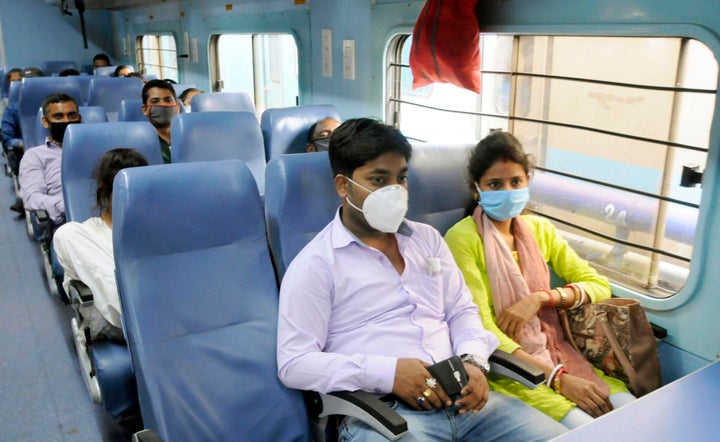
India has been resuming flight operations and train and cab services in a regulated manner as the country gradually starts easing restrictions after a series of lockdowns to limit the spread of Covid-19.
Before flight services were resumed, concerns were raised about the risk of the novel coronavirus being transmitted through air. A study in China had suggested that A/C could help the transmission of the virus, citing the example of 10 Covid-19 patients from three families who picked up the infection by eating at neighbouring tables in a restaurant.
The Indian Railways’ decision to run fully air-conditioned trains last month was also questioned by health experts. There is greater risk of virus transmission in closed facilities, The News Minute quoted experts as saying.
The Railways had then dismissed the concerns, saying that travelling in AC coaches poses no risk of coronavirus transmission. Railways officials also said in a statement that as per the Ministry of Health’s guidelines, centralised AC is acceptable if complete air change inside an AC coach takes place at least 12 times per hour.
“The Roof Mounted AC Package Unit (RMPU) system of Indian Railways AC coaches is designed to have a higher air replacement rate and we are ensuring that our system replaces air more than 12 times per hour as per these guidelines,” the officials had added, according to India Today.
Railways began operating 200 special trains across the country from Monday. In a press release, it said the services will be in addition to the existing Shramik Special trains and Special AC trains. These are fully reserved trains having both AC and non-AC classes, it added.
With more Indians beginning to travel now, HuffPost India spoke to two air quality experts on how effective the government’s strategy of air replacement in trains is and how safe it is to travel in an AC cab even when you wear masks and try to practise social distancing.
Trains
While the Railways has said that it will completely change the air within AC coaches at least 12 times every hour, this is not an easy task.
Barun Aggarwal, CEO of indoor air quality solutions provider BreatheEasy, explained that Air Changes per Hour (ACH) is a measure that is used to calculate the number of times air gets “changed” in one hour—technically this means that the existing air is completely replaced with fresh outside air.
Aggarwal explained that mechanical ventilation systems use industrial fans to bring in outside air and replace the indoor air. Once the amount of air coming from outside is measured to be equal to the amount of indoor air, he added, it is considered as 1 air change. If this happens 5 times in an hour, it is considered as 5 ACH, he said.
He also pointed out that sometimes this is misinterpreted as the number of times the air gets recirculated by the AC system. “This will only keep recirculating stale air (12 times) but not actually change the air. If there is a virus particle in the air, it could likely infect other people unless they are truly ‘changing’ the air with outdoor (or fresh) air 12 times every hour. It is unlikely they will do this as the CO2 levels measured by us in various AC trains has been very high — which means that the air is recirculated and not changed,” he added.
Aggarwal, co-author of a book How To Grow Fresh Air, suggested additional steps that the government should take to ensure safe train travel.
He said that the five main pillars of Heating, Ventilation, and Air Conditioning (HVAC) systems are (a) ventilation (dilution) with “fresh air”, (b) filtration with certified HEPA filters, (c) relative humidity between 40-70%, (d) temperature between 24-30 degrees and (e) draft – the draft should be minimised by running the fan at lowest speed so as to minimise chances of virus being airborne and travelling in the air.
Mansoor Ali, Research Analyst and Founder of AMFAH India, which makes air purifiers and dehumidifiers, also told HuffPost India that the fresh air that replaces the stale air needs to be treated. “Travelling in the AC coaches contains risk due to non-treatment of circulating air,” he said, suggesting installation of suitable UV systems in the HVAC of the coach.
Ali suggested treating the circulated air with powerful UV. “When the AC coach after or prior to a journey is parked in the car shed, it should be flooded with coach Ozone gas UV lamps,” he said.
Cabs
For travelling in an AC cab, Aggarwal said any AC system that “recirculates air within a cabin” can be harmful if any of the occupants is an asymptomatic carrier.
“In a cab, keep the windows rolled down a little (even 1-2 inches) when AC is on, and if possible, get a high quality air purifier in the vehicle cabin,” he said.
Ali said that when travelling in a cab, it’s preferable not to turn on the AC and roll down the windows. He, however, said that AC can be used in personal vehicles.
For the latest news and more, follow HuffPost India on Twitter, Facebook, and subscribe to our newsletter.
Flights
The risk of transmission is low inside an aircraft. Aggarwal said aircrafts are typically fitted with the best-in-class air filtration systems with certified HEPA filters. This, he said, ensures that a part of the air that is recirculated is filtered completely. Aircrafts are also fitted with pressurisation systems to pull in “fresh air” for ventilation and dilution, he said, adding that is why the CO2 level stays between 1,000 and 1,600 ppm in an aircraft.
Some aircrafts have an airflow system that is top to bottom (versus front to back), he said, and this ensures that the air that one person exhales is not inhaled by others sitting behind them.